Podcast: Play in new window | Download
This week: Just in time for (Greek) Easter, esteemed egg expert Peter (er, my husband) cooks the perfect hard-boiled egg in real time. Use this episode as your own egg timer at home!
Continue reading
Podcast: Play in new window | Download
This week: Just in time for (Greek) Easter, esteemed egg expert Peter (er, my husband) cooks the perfect hard-boiled egg in real time. Use this episode as your own egg timer at home!
Continue readingPodcast: Play in new window | Download
It’s a full decade since I first made this podcast, but the lessons all still hold true, so I’m rerunning the old episodes as is. I just added a short preamble to the first full episode (replacing my slightly ranty original episode 1). The premise: cooking a weeknight meal in about an hour. Ideally, you’ll cook along and learn a bit about how to work more efficiently and creatively in the kitchen.
Continue readingPodcast: Play in new window | Download
This week, we cook a little risotto–it’s not as complicated or as fussy as you think. And it’s a very adaptable dish. On the side, we roast up some wee brussels sprouts and douse them in garlic and anchovies–what’s not to love?
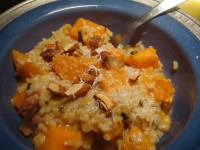 Learn to make risotto, and you’ve got an immensely versatile dish under your belt–you can throw just about anything in. This combination capitalizes on fall flavors–squash and sage, with a boost of bacon (though that’s optional). The nuts on top (almonds here, but you could use hazelnuts or even pecans) add a little extra protein, as well as essential crunch–it’s the variety of textures that take this from gooey side dish to main-meal material.
Learn to make risotto, and you’ve got an immensely versatile dish under your belt–you can throw just about anything in. This combination capitalizes on fall flavors–squash and sage, with a boost of bacon (though that’s optional). The nuts on top (almonds here, but you could use hazelnuts or even pecans) add a little extra protein, as well as essential crunch–it’s the variety of textures that take this from gooey side dish to main-meal material.
Serves 2 generously
1 small winter squash or pumpkin (see note)
Olive oil
Salt
1 1/2 cups chicken or vegetable broth
1 slice thick-cut bacon
1 small onion
2 large pinches dried sage (or 10-12 leaves fresh, chopped fine)
1/2 cup short-grain rice (see note)
Parmesan
1 tablespoon butter
Large handful (1/4 cup or so) almonds
Preheat oven to 400. Slice squash into large wedges, scrape out seeds then cut off peel with a sharp knife. Cut squash into small pieces–1/2-inch square or so, though irregular sizes are fine, and even a bonus here, as the smallest ones will get quite soft and blend in with the risotto, and others will stay firmer and whole. Toss the pieces with a drizzle or two of olive oil, just to coat, and lay the pieces out on a baking sheet or (if not too crowded) a heavy skillet. Sprinkle with a bit of salt. Place in oven and roast for about 30 minutes, until the squash is soft all the way through.
Pour broth into a small saucepan and set on a back burner on low heat to warm. Cut bacon into 1/4-inch pieces and set to fry over medium heat in a heavy-bottomed saucepan–this is the pan you’ll be making your risotto in.
Cut onion into thin slices. When the bacon is half-crispy, add the onions to the pan, along with a pinch of salt, and stir and fry. Add the sage and continue to cook, until the sage is fragrant and the onions are translucent and soft–this can take 5 minutes or so. When the onions are ready, add the rice. Stir and fry until the rice is coated with oil and somewhat translucent.
Add a couple of ladlesful of warm stock and stir thoroughly to combine. If you have nothing else to do in the kitchen, continue to stir. (If you do have other tasks, you can leave the risotto unattended until you hear the liquid cooking away.) Continue to stir and add stock, ladleful by ladleful, as the rice absorbs the liquid and a velvety sauce forms around the rice. Depending on your rice, you may or may not use all of the stock–I usually wind up just adding everything I’ve heated up, and it usually turns out fine.
When rice is al dente–it still has a bit of firmness to it–and the mixture is fairly loose (it will thicken as it sits), turn off the heat. Grate in a generous amount of Parmesan cheese, and stir in the butter. Put the lid on the pan and let the risotto sit for about 5 minutes.
During this time, roughly chop your almonds and toast them in a dry skillet over high heat, just until lightly browned. Remove them from the hot skillet as soon as they’re browned to your liking.
Stir the roasted squash into the thickened risotto, squishing up some of the smaller pieces. (How much squash you add depends on your taste–you might have some squash left over.) Place in serving bowls and sprinkle over the toasted almonds, along with a bit more grated Parmesan.
Notes:
Squash: You can use butternut, kabocha or acorn squash–anything that’s firm, orange and a bit sweet. In the podcast, I use a wedge of calabaza–a kind of pumpkin that’s used in Latin America and the Caribbean. Butternut squash is by far the most common, but it’s hard to find small enough squash so that you won’t be overwhelmed with it when cooking for just a couple of people–but leftover roast squash is not a bad thing to have around. (And please avoid that precut squash! Who knows how many days/weeks it’s been sitting around! Really, it takes very little time to peel and prep a squash.)
Rice: Classic risotto recipes call for arborio rice, an Italian grain that’s hard to find and expensive when you do. I have found that Japanese sushi rice works quite well too–it happens to be much easier for me to buy, and it’s significantly cheaper. But any short-grain rice will work reasonably well.
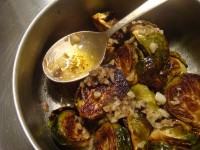 As I say in the podcast, when in doubt with vegetables, roast them. Brussels sprouts roast up particularly well, getting a nice crunchy outside and sweetening a bit in the process. Even if you think you don’t like brussels sprouts, try them once this way–I think you’ll change your mind. Dousing them in anchovies and garlic (skip the anchovies if you’re veg, obviously–it will still be tasty) makes them incredibly savory, and a nice counterpoint to the sweetness of the squash in the risotto.
As I say in the podcast, when in doubt with vegetables, roast them. Brussels sprouts roast up particularly well, getting a nice crunchy outside and sweetening a bit in the process. Even if you think you don’t like brussels sprouts, try them once this way–I think you’ll change your mind. Dousing them in anchovies and garlic (skip the anchovies if you’re veg, obviously–it will still be tasty) makes them incredibly savory, and a nice counterpoint to the sweetness of the squash in the risotto.
Serves 2
1 pint brussels sprouts
Olive oil
Salt
2 or 3 cloves garlic
2 or 3 anchovy filets
Preheat oven to 400. Trim bottom ends of brussels sprouts and slice in half lengthwise. Drizzle a bit of olive oil on a baking sheet, then lay out the sprouts, cut side down, rubbing each one in oil. Drizzle a bit of oil over the tops of the sprouts as well, and sprinkle with salt. Roast until the cut sides are nicely browned, about 30 minutes.
Set a small saucepan over medium heat. Pour in a glug of olive oil. While it’s warming, chop your garlic cloves fine or squeeze them through a press. When the oil is hot, add the anchovy filets, mashing them with the side of your spoon, so they melt into small pieces. Add the garlic and stir and fry until fragrant.
Put the roasted sprouts in a serving bowl, then pour the hot anchovy-garlic mixture over them and toss lightly.
Podcast: Play in new window | Download
This week, I make an easy, summery pasta dish, plus arugula that’s a nice variation from the usual salad. It all comes together very quickly, and doesn’t heat up the kitchen much–great when the weather is hot.
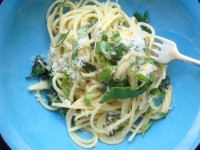 I cook this all the time in the summer–there’s something about the flavor combination that’s so refreshing, and in the summer, I don’t really feel like I need a big meaty main dish. I learned the recipe from a surprisingly good free promotional cookbook I got from the Parmigiano-Reggiano people a good ten years ago, and to be fair, the quality of the grating cheese does make a difference. So use Parmigiano-Reggiano, ideally, or, in a budgetary pinch, Grana Padano, though you’re not using so much that genuine Parm will break the bank.
I cook this all the time in the summer–there’s something about the flavor combination that’s so refreshing, and in the summer, I don’t really feel like I need a big meaty main dish. I learned the recipe from a surprisingly good free promotional cookbook I got from the Parmigiano-Reggiano people a good ten years ago, and to be fair, the quality of the grating cheese does make a difference. So use Parmigiano-Reggiano, ideally, or, in a budgetary pinch, Grana Padano, though you’re not using so much that genuine Parm will break the bank.
For 2 servings
1 lemon
Large handful fresh basil leaves
Half-inch chunk of Parmesan
3-4 tablespoons butter
1/2 pound spaghetti
Salt, to taste
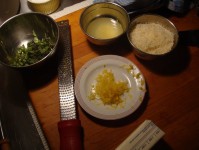 Set a pot with heavily salted water on to boil. Then get all the pasta ingredients ready (as in the photo): grate the zest from the lemon into a small bowl, then squeeze the lemon juice into another small bowl–you’ll want about 1 tablespoon total, maybe a dash more. Rinse the basil well, then slice into thin strips. Grate the Parmesan cheese–you should have about 1/3 cup. Measure out your butter.
Set a pot with heavily salted water on to boil. Then get all the pasta ingredients ready (as in the photo): grate the zest from the lemon into a small bowl, then squeeze the lemon juice into another small bowl–you’ll want about 1 tablespoon total, maybe a dash more. Rinse the basil well, then slice into thin strips. Grate the Parmesan cheese–you should have about 1/3 cup. Measure out your butter.
In a heavy skillet (the same one you will have prepared the arugula in is fine) on medium heat, melt the butter, then add the lemon zest and juice and let simmer for a minute or so. (You can do this part in advance and let it sit until the pasta is cooked.)
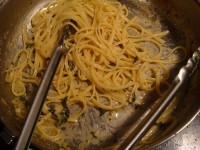 Cook the pasta according to the package directions–usually 6-8 minutes. When it’s just al dente (err toward less done), set aside a bit of the pasta water in a mug, then drain the rest of the pasta. Toss it into the skillet with the butter (turn the heat back on to medium, if it has been sitting), and stir the pasta to coat evenly (tongs are good here). Gradually shake in all but about 1 tablespoon of the cheese, stirring the pasta constantly. If the mixture gets a bit dry or too sticky (as in the photo), add a tablespoon or two of the reserved pasta water. Finally, toss in the basil and turn off the heat. Taste for salt (you may not need any if you’ve salted your pasta water well, and used salted butter). Serve with the reserved cheese sprinkled on top.
Cook the pasta according to the package directions–usually 6-8 minutes. When it’s just al dente (err toward less done), set aside a bit of the pasta water in a mug, then drain the rest of the pasta. Toss it into the skillet with the butter (turn the heat back on to medium, if it has been sitting), and stir the pasta to coat evenly (tongs are good here). Gradually shake in all but about 1 tablespoon of the cheese, stirring the pasta constantly. If the mixture gets a bit dry or too sticky (as in the photo), add a tablespoon or two of the reserved pasta water. Finally, toss in the basil and turn off the heat. Taste for salt (you may not need any if you’ve salted your pasta water well, and used salted butter). Serve with the reserved cheese sprinkled on top.
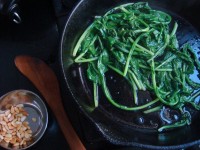 This preparation takes a little of the intense peppery bite out of arugula, so give it a try even if you’re not ordinarily an arugula fan. And the basic technique–wilting greens with a little bit of liquid in a hot, covered pan–is one you can apply to all kinds of greens. Pine nuts add a little crunch and additional protein, to make the dish just a tad more substantial. Fish sauce is optional (a shortcut to melting anchovies in the hot olive oil before adding the greens), but it adds just a touch of extra richness. To save on cleanup, you can make it in the same pan you’ll later finish the pasta in.
This preparation takes a little of the intense peppery bite out of arugula, so give it a try even if you’re not ordinarily an arugula fan. And the basic technique–wilting greens with a little bit of liquid in a hot, covered pan–is one you can apply to all kinds of greens. Pine nuts add a little crunch and additional protein, to make the dish just a tad more substantial. Fish sauce is optional (a shortcut to melting anchovies in the hot olive oil before adding the greens), but it adds just a touch of extra richness. To save on cleanup, you can make it in the same pan you’ll later finish the pasta in.
For 2 servings
1 medium bunch fresh arugula
Olive oil
2 small handfuls pine nuts
Fish sauce (or salt)
Pinch red pepper flakes (Aleppo pepper is ideal; Italian pepper flakes will do too)
Rinse your arugula very well, but no need to dry. Set a heavy skillet over medium heat and drizzle in a glug of olive oil. When the pan is hot, toss in the pine nuts and stir occasionally till nicely browned, usually less than a minute. Remove the nuts and set aside.
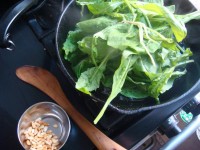 Throw the wet arugula in the pan, and stand back a bit to avoid any spattering oil. (If you’re starting with dry greens, toss them in, then add a tablespoon or two of water.) They won’t look like it’s all going to fit (as in the photo), but as you stir quickly (tongs can be useful here) to coat the leaves with oil, they will start to wilt immediately. Then put the lid on the pan and turn the heat to medium-low. Cook, covered, for just 20-30 seconds, until the arugula is completely wilted, but still bright green.
Throw the wet arugula in the pan, and stand back a bit to avoid any spattering oil. (If you’re starting with dry greens, toss them in, then add a tablespoon or two of water.) They won’t look like it’s all going to fit (as in the photo), but as you stir quickly (tongs can be useful here) to coat the leaves with oil, they will start to wilt immediately. Then put the lid on the pan and turn the heat to medium-low. Cook, covered, for just 20-30 seconds, until the arugula is completely wilted, but still bright green.
Remove the greens from the pan immediately to stop the cooking, then drizzle on a few drops of fish sauce (if you have it) and stir. If you want to stay veggie, or you don’t have fish sauce, just sprinkle on a bit of salt. Top with red pepper flakes and serve. (This can sit and cool a little–it doesn’t need to be served piping hot.)
Podcast: Play in new window | Download
This week, by special request from a fellow New Mexican, I cook up a batch of the distinctive red chile sauce used all over everything in New Mexico.
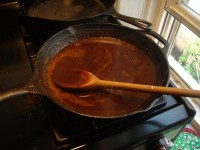 I usually eat this on scrambled or fried eggs, topped with some grated cheese and briefly melted under the broiler. You can of course use it for a batch of enchiladas (you might want to double the recipe), but I find I rarely get there before I eat it all up. It’s also good dropped in posole (hominy stew). It lasts for about a month in the refrigerator, in a tightly sealed jar, and it tastes better if you let it sit overnight and reheat.
I usually eat this on scrambled or fried eggs, topped with some grated cheese and briefly melted under the broiler. You can of course use it for a batch of enchiladas (you might want to double the recipe), but I find I rarely get there before I eat it all up. It’s also good dropped in posole (hominy stew). It lasts for about a month in the refrigerator, in a tightly sealed jar, and it tastes better if you let it sit overnight and reheat.
As I say in the podcast, purists often don’t use any spices at all. If you do use them, go light–too much cumin or oregano can make the whole thing taste kind of muddy and cheap.
Makes about 2 1/4 cups
1/2 cup ground New Mexico red chile
scant 2 tbsp flour (about 2 heaping teaspoons)
1/4 tsp ground cumin (optional)
1/2 tsp ground coriander (optional)
2 tbsp lard or vegetable oil
2 cloves garlic
2 cups water or chicken stock
Pinch salt
Pinch dried oregano (optional)
Turn on your kitchen fan or open a window–the oils in the chile can make you cough.
Heat a heavy skillet over medium heat. Add the chile, flour, and, if using, cumin and coriander, and quickly stir to toast the spices, just until fragrant and the chile darkens slightly. Take the skillet off the heat if you’re worried the chile has gone too far, and continue to stir the dry mix until it cools a little.
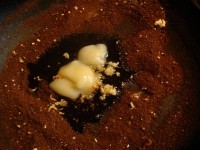 Scrape the dry mix to the sides of the pan to leave an empty spot in the center. Squeeze the two garlic cloves through a press (or mince the garlic very finely beforehand) into the center of the pan, then add the vegetable oil or lard. Stir and fry the garlic until fragrant, then incorporate the dry spices into the oil to make a very thick, dry paste. Fry this a little bit more–maybe just 10 seconds or so, max.
Scrape the dry mix to the sides of the pan to leave an empty spot in the center. Squeeze the two garlic cloves through a press (or mince the garlic very finely beforehand) into the center of the pan, then add the vegetable oil or lard. Stir and fry the garlic until fragrant, then incorporate the dry spices into the oil to make a very thick, dry paste. Fry this a little bit more–maybe just 10 seconds or so, max.
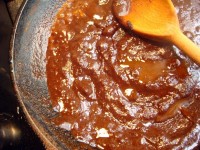 Slowly add the water or chicken stock, stirring constantly and working out any lumps you see. The sauce will thicken almost instantly (as in the photo), but by the time you’ve added the full 2 cups of water, it will be quite thin again–this is fine. Add a pinch of salt, and some oregano if you like.
Slowly add the water or chicken stock, stirring constantly and working out any lumps you see. The sauce will thicken almost instantly (as in the photo), but by the time you’ve added the full 2 cups of water, it will be quite thin again–this is fine. Add a pinch of salt, and some oregano if you like.
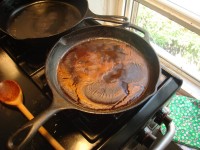 Bring the sauce up to a boil, then immediately turn down to the lowest heat, so that it is just simmering. Let simmer for about 20 minutes or so, until it’s a bit thicker. Stir it occasionally to work in the skin that forms on the top (as in the photo). If it gets very thick, you can always thin it with a bit more water.
Bring the sauce up to a boil, then immediately turn down to the lowest heat, so that it is just simmering. Let simmer for about 20 minutes or so, until it’s a bit thicker. Stir it occasionally to work in the skin that forms on the top (as in the photo). If it gets very thick, you can always thin it with a bit more water.
Store in a jar in the refrigerator. When reheating, you’ll probably need to add a bit of water to thin the sauce out again.
*Lard: Use good freshly rendered stuff (ask for manteca at your Mexican grocery), not the hydrogenated Armour blocks. If you can’t get the good stuff, use vegetable oil.
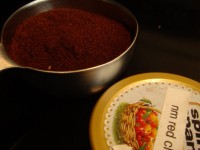 *Chile: Purists usually start not with ground chile, but with whole New Mexican chile pods. And these might also be easier to find outside of New Mexico than the ground chile. Look in your Mexican grocery–they’re often sold alongside all the other varieties (ancho, mulato, etc.) and labeled “New Mexican.” If you’re starting with whole pods, pull of the stems, then crack them open and pull out all or most of the seeds, depending on how much heat you want. (Oh yeah–and one New Mexican cookbook I have advises you to wipe the dust off the chiles first–presumably if they’ve been hanging around on a ristra.) Lay the chile pods out on a cookie sheet and toast them in a 400-degree oven for about five minutes, until they darken and dry out a little bit. Then let them cool, and whiz them up in a spice grinder or a blender. (The cooling is important–hot chiles will release tons of oils into the air, which are painful to breathe.) Then proceed with this recipe, skipping the bit about toasting everything in a dry pan.
*Chile: Purists usually start not with ground chile, but with whole New Mexican chile pods. And these might also be easier to find outside of New Mexico than the ground chile. Look in your Mexican grocery–they’re often sold alongside all the other varieties (ancho, mulato, etc.) and labeled “New Mexican.” If you’re starting with whole pods, pull of the stems, then crack them open and pull out all or most of the seeds, depending on how much heat you want. (Oh yeah–and one New Mexican cookbook I have advises you to wipe the dust off the chiles first–presumably if they’ve been hanging around on a ristra.) Lay the chile pods out on a cookie sheet and toast them in a 400-degree oven for about five minutes, until they darken and dry out a little bit. Then let them cool, and whiz them up in a spice grinder or a blender. (The cooling is important–hot chiles will release tons of oils into the air, which are painful to breathe.) Then proceed with this recipe, skipping the bit about toasting everything in a dry pan.
*Shameless self-promotion: I happen to write two guidebooks to New Mexico for the Moon Handbooks series. If you’re planning a trip to the state (and you should, to get more chile!), check them out here and here.
Podcast: Play in new window | Download
This week, I make an easy pilaf with Middle Eastern flavors: dates and cinnamon, plus salty feta. Green beans pickled with dill and garlic are on the side, and for dessert, we have a quick trick for making strawberries taste their best. It’s all quite quick, and ideal for hot weather, when you don’t want the stove on for too long.
Click to play this episode in a new window; right-click to download
Subscribe via iTunes
Subscribe via RSS
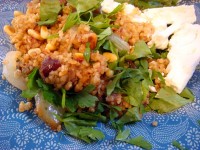 I got the basic idea for this pilaf from the excellent Moosewood Cookbook Cooks at Home, which I recommend as a good beginner cookbook even if you don’t happen to be vegetarian. (See my blog, Roving Gastronome, for more about what’s great about the book.) In that cookbook, the base is precooked rice, and that works very well. I just like the chewy texture of bulgur, and it cooks very quickly. You can use whatever combination of ground or whole spices you happen to have.
I got the basic idea for this pilaf from the excellent Moosewood Cookbook Cooks at Home, which I recommend as a good beginner cookbook even if you don’t happen to be vegetarian. (See my blog, Roving Gastronome, for more about what’s great about the book.) In that cookbook, the base is precooked rice, and that works very well. I just like the chewy texture of bulgur, and it cooks very quickly. You can use whatever combination of ground or whole spices you happen to have.
For about 4 servings
1-2 tbsp butter or olive oil
1 medium onion
Pinch salt
6 large dates
Large pinch ground cinnamon, plus 1 or 2 cinnamon sticks (optional)
Pinch ground allspice, plus 5 or 6 whole allspice berries (all optional)
1 1/2 cups bulgur (no. 2 grind, ideally)
2 1/4 cups water
Large handful pine nuts or almonds
Large handful parsley
Feta cheese, however much you like (goat cheese also works)
In a heavy saucepan with a tight-fitting lid, melt your butter or heat your olive oil over medium heat. Slice up your onion and toss it in, along with a generous pinch of salt. While the onions are softening up, slice up your dates into smallish bite-size pieces, then toss them in with the onions. Add the cinnamon and allspice and stir. Once the onions are soft and translucent, pour in the bulgur and stir to coat with oil (add a tiny bit more if you need to). Then pour in the water, give a good stir and put the lid on. Let the mix come to a boil, then turn down to the lowest simmer.
While the bulgur is simmering, chop your parsley coarsely. In heavy skillet over high heat, toast the pine nuts until just golden brown; immediately remove from the hot pan when they’re done. Set out your feta (or goat) cheese.
Check your bulgur after about 10 minutes. You want it to be chewy, and all of the water should be absorbed–if it’s still crunchy, put the lid back on for another minute or two. A lot depends on the weight of your pot and the flame on your stove. It’s OK if the bottom layer gets a bit dried and stuck to the bottom of the pot, but be careful not to let it scorch. If the bulgur is sticking and the texture is good, but the whole mix is still a bit moist, turn off the heat, fluff the bulgur up with a fork and leave the lid off for a few minutes, to let some of the steam dissipate.
Serve with parsley (you can mix it in with the bulgur, or sprinkle it on each serving) and toasted pine nuts–sprinkle these over the top, so they don’t get soggy. Set a slab of feta cheese on the side, or crumble it over the top.
Leftovers are good at room temperature; be sure to store any extra pine nuts separately, so they keep their texture.
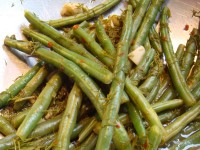 This is a great, simple treatment for green beans, and works for other crispy or relatively firm vegetables as well. You can vary the herbs and spices that go in as well–though if you had many more spices, you should probably remove the green herbs altogether, or the flavors will get too muddled. Dried herbs can work nearly as well as fresh–if you’re using them, add them to the vinegar mix just at the end of the boiling, so they get a bit rehydrated.
This is a great, simple treatment for green beans, and works for other crispy or relatively firm vegetables as well. You can vary the herbs and spices that go in as well–though if you had many more spices, you should probably remove the green herbs altogether, or the flavors will get too muddled. Dried herbs can work nearly as well as fresh–if you’re using them, add them to the vinegar mix just at the end of the boiling, so they get a bit rehydrated.
For about 3 side servings
2-3 large handfuls green beans (about 1 lb.)
Large handful fresh dill (or 1 heaping tbsp dried dill)
3 or 4 garlic cloves, peeled and roughly crushed (or 2 garlic cloves, peeled and minced fine or pressed)
Large pinch red pepper flake (optional)
About 1/3 cup cider vinegar (or other fruity variety)
Small dab honey or sugar, less than 1/2 teaspoon
Set large pot of generously salted water on to boil. Rinse beans and snap stem ends off; remove tips if soft. Rinse dill and chop coarsely; set in a large stainless-steel bowl. Boil beans for about 1 minute, until bright green and just barely soft, then set in bowl with dill.
While beans are boiling, combine garlic, red pepper, vinegar and honey in a small nonreactive (stainless steel) saucepan and boil for 1-2 minutes. Pour hot liquid over beans and dill, stir to combine and set aside for at least 10 minutes. Taste for salt right before serving–it may need a little extra. The flavor will develop the longer they sit, and they keep for several days in the fridge.
 This is an excellent treatment for good strawberries, and it also helps save ones that aren’t quite as good as they should be. For two people, simply wash, trim and roughly slice about six big strawberries. Place in a bowl and dust with a small amount of sugar–only about 1/2 tsp. Then sprinkle over about 1 teaspoon balsamic vinegar, just enough to coat the berries. (If in doubt, add less, not more–there should just be a slight slick of vinegar in the bowl, not a pool in the bottom.)
This is an excellent treatment for good strawberries, and it also helps save ones that aren’t quite as good as they should be. For two people, simply wash, trim and roughly slice about six big strawberries. Place in a bowl and dust with a small amount of sugar–only about 1/2 tsp. Then sprinkle over about 1 teaspoon balsamic vinegar, just enough to coat the berries. (If in doubt, add less, not more–there should just be a slight slick of vinegar in the bowl, not a pool in the bottom.)
Let sit for at least 20 minutes, but not more than a couple of hours. The strawberries will give off some of their juices–combined with the sugar and vinegar, it makes a very light syrup. The strawberries are great on ice cream, or with Greek yogurt.
Note: In the podcast, I use a bit of oxymeli, rather than balsamic vinegar. It’s extremely delicious, and more complex, but I’m not sure the stuff is easily available. Still, if you happen to see it, it’s an intriguing treat…
Podcast: Play in new window | Download
This week: a simple dinner of pasta and salad, but with an interesting, Greek-inspired combination of flavors (plus bacon!) in the pasta, and a fresh green salad with easy homemade dressing.